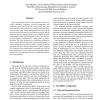Free Online Productivity Tools
i2Speak
i2Symbol
i2OCR
iTex2Img
iWeb2Print
iWeb2Shot
i2Type
iPdf2Split
iPdf2Merge
i2Bopomofo
i2Arabic
i2Style
i2Image
i2PDF
iLatex2Rtf
Sci2ools
WICSA
2004
2004
The DiPS+ Software Architecture for Self-healing Protocol Stacks
Research domains such as active networks, ad-hoc networks, ubiquitous computing, pervasive computing, grid computing, and sensor networks, clearly show that computer networks will become more complex and heterogeneous. In many cases, central management and control of the network are far from trivial since both the topology and the connected devices change rapidly in such highly dynamic environments, while load circumstances may vary arbitrarily. The software architecture in a node needs to support flexibility. We have developed an architecture tailored to protocol stack software that allows customizing internal resource management in order to handle overload conditions gracefully. We show that the investment in explicit support for modularity and architectural constraints pays off: the paper elaborates on a case study in which dynamic adaptation of access control behavior leads to significant performance improvements.
| Added | 31 Oct 2010 |
| Updated | 31 Oct 2010 |
| Type | Conference |
| Year | 2004 |
| Where | WICSA |
| Authors | Sam Michiels, Lieven Desmet, Wouter Joosen, Pierre Verbaeten |
Comments (0)

